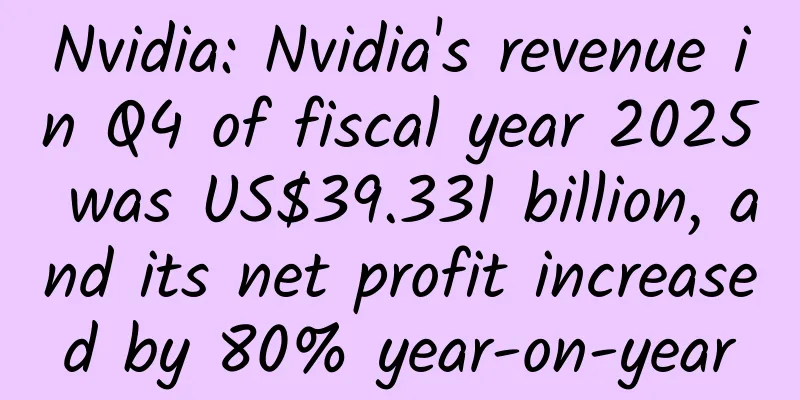Nvidia: Nvidia's revenue in Q4 of fiscal year 2025 was US$39.331 billion, and its net profit increased by 80% year-on-year

|
AI (artificial intelligence) chip leader Nvidia's revenue exceeded expectations last quarter and gave strong performance guidance. After the U.S. stock market closed on February 26, local time, Nvidia (Nasdaq: NVDA) released its fourth quarter financial report for fiscal year 2025 ending January 26, with revenue of US$39.331 billion, up 78% year-on-year, higher than the market expectation of US$38.05 billion; net profit under US Generally Accepted Accounting Principles (GAAP) was US$22.091 billion, up 80% year-on-year; Non-GAAP diluted earnings per share were US$0.89, up 82% year-on-year, higher than the market expectation of US$0.84. For the entire fiscal year 2025, Nvidia's revenue reached US$130.5 billion, up 114% year-on-year. Non-GAAP diluted earnings per share were US$2.99, up 130% year-on-year. The company spent US$33.7 billion on stock repurchases in fiscal year 2025. At the same time, Nvidia provided guidance for the next quarter's performance, predicting that sales in the first quarter of fiscal 2026 will reach $43 billion, with a fluctuation of 2%, which means a year-on-year increase of 65%, higher than the market average expectation of $41.78 billion. Nvidia will maintain its quarterly dividend of 1 cent per share. “Demand for Blackwell chips has been amazing because inference AI has added another scaling law - more computing power during training makes the model smarter, and more computing power invested in deep thinking makes the answer smarter,” said Jensen Huang, CEO of NVIDIA. “We have successfully achieved large-scale production of Blackwell AI supercomputers, and achieved billions of dollars in sales in its first quarter. AI is advancing at the speed of light, with agent AI and physical AI laying the foundation for the next wave of the AI revolution, which will transform some of the largest industries.” Summary of Nvidia's fourth quarter results for fiscal year 2025. Source: Nvidia's financial report On the 26th, Nvidia (Nasdaq: NVDA) closed at $131.28 per share, up 3.67%, with a total market value of $3.22 trillion. After the earnings report was released after the market, Nvidia's stock price fluctuated violently, falling 2% at one point, and turned to rise after the earnings call began, but then fell again. As of press time, the company's stock price fell slightly. It is worth noting that in the fourth quarter, the company's gross profit margin reached 73.0%, a year-on-year decrease of 3.0% and a month-on-month decrease of 1.6%. Nvidia said that the reason for the decline in gross profit margin is that new products in data centers are more complex and expensive, and this business is the company's largest source of revenue to date. After Blackwell is fully put into production, the gross profit margin is expected to increase to around 75% later in fiscal 2026. Blackwell Ultra will be launched as planned in the second half of this year In terms of business, Nvidia's most watched data center business once again hit a record high. Nvidia's fourth-quarter data center business revenue was $35.6 billion, higher than the market expectation of $33.65 billion, an increase of 93% year-on-year and 16% quarter-on-quarter. Nvidia CFO Colette Kress said that sales of the latest AI chip Blackwell "exceeded expectations", bringing in $11 billion in revenue in the fourth quarter, making it the company's fastest-growing product ever, and its production is "running at full speed": "Large cloud service providers lead sales of Blackwell chips, which account for about 50% of our data center revenue." Kress emphasized: "The scale of post-training and model customization (of AI models) is very large, and driven by test time expansion and new inference models such as OpenAI's o3, DeepSeek R1, and Grok 3, it may require orders of magnitude more computational acceleration." Huang added that the Blackwell product line is expected to "achieve incredible results across the board": "We have to continue to scale because the demand is quite large and customers are eager to get their hands on the Blackwell systems." The company believes that as supply increases and restrictions ease, it expects to achieve strong month-on-month growth in the first quarter. However, Kress noted that the company's data center revenue in China was "well below expectations," product shipments will "roughly remain at current proportions," and that revenue from the U.S. data center business was strongest, driven by Blackwell chips. In addition, the impact of future tariffs remains an unknown. Huang Renxun also said in the conference call that the revenue share of China's business in this fiscal quarter is expected to be roughly the same as that in the fourth fiscal quarter and before, "about half of that before the implementation of export controls." He added that it is best to think of AI chips as software that is "ubiquitous in every country" and "every student will use AI as a tutor." Regarding the company's AI chip roadmap, Huang Renxun admitted that the transition from the previous generation Hopper architecture to the Blackwell architecture was a "very challenging transition". The company encountered "minor problems" in the early production process of Blackwell, which "may have wasted several months", but NVIDIA recovered at "light speed" and it is expected that the transition to Blackwell Ultra will be smoother and will be available in the second half of this year. In terms of other businesses, as Nvidia's "main business", the gaming and AI PC (artificial intelligence personal computer) business had revenue of $2.5 billion in the third quarter, down 22% from the same period last year. In addition, the professional visualization business had revenue of $511 million, up 10% from the same period last year and up 5% from the previous quarter. The automotive and robotics business had revenue of $570 million, up 103% from the same period last year and up 27% from the previous quarter. Huang Renxun praised DeepSeek-R1 for "igniting global enthusiasm" Previously, on January 20, Chinese AI startup DeepSeek launched the cost-effective and high-performance open source large model DeepSeek-R1, which subsequently caused a sensation in the international market, causing Nvidia's market value to evaporate by US$600 billion in just three days from January 24. In the final summary of the post-earnings conference call, Huang Renxun said that DeepSeek-R1 "ignited global enthusiasm" and that the inference model will drive the development of the chip business: "The inference model consumes 100 times the computing power, and future inference models will consume even more computing power. Deepseek-R1 ignited global enthusiasm, which is an excellent innovation. More importantly, it has open-sourced a world-class inference AI model, and almost every AI developer is using R1." In an interview program aired recently, Huang Renxun called DeepSeek's open source inference model R1 "exciting", and there were some misunderstandings in the market's reaction to R1. The release of R1 is essentially good for the AI market and can accelerate the adoption of AI, which means that the market still needs computing resources. Currently, the market is closely watching whether large technology companies will continue to invest heavily in AI infrastructure construction and whether the investment can bring corresponding returns. According to reports from Microsoft, Google, Amazon and Meta, the total capital expenditure of the four giants in 2024 will be US$246 billion, a year-on-year surge of 63%, and the total capital expenditure in 2025 may exceed US$320 billion. Microsoft will account for nearly 35% of Nvidia's total revenue from Blackwell, its latest AI chip, in 2025, with Google accounting for 32.2%, Oracle accounting for 7.4% and Amazon accounting for 6.2%, according to a forecast released by Morgan Stanley analysts in February. In a conference call, Huang said: "Even if a chip is designed, it doesn't mean it can be deployed." When asked whether Nvidia's business would be threatened by companies such as Amazon, Microsoft and Google developing their own custom chips, Huang said: "Even if a chip is designed, it doesn't mean it can be deployed." According to Factset data, before the earnings report was released, 62 of 68 analysts gave Nvidia a "buy" or "outperform" rating, and the remaining 6 gave a "hold" rating. Analysts gave Nvidia an average target price of $175.39. |
<<: Changing life: Samsung/Xiaomi/NFC-SIM bus swiping experience
>>: Is KMS dangerous? How is the genuine version of Windows different from the pirated one?
Recommend
Why does he have invincible immunity? Scientists have made new research discoveries!
Bats are amazing creatures. Not only are they the...
Website testing analysis report, how to write website experience report?
When a website needs to be built, revised or its ...
How to make sign-in a powerful tool to increase user activity!
This article will explain which apps are suitable...
Christine's "Xianyu Operation Advanced Course" is a part-time e-commerce project for novices to quickly get started
Christine Xianyu Operation Advanced Course [2022 ...
Wu Bangzhu's "Authentic Hitting the Board" Ningbo Hot Money Direct Line, a trick to hit the board that everyone can learn
Contents: 1. Why do I say that the first board is...
Information flow advertising delivery is unstable, how to optimize it?
Written in front In response to recent feedback fr...
Is 5G real or fake? A few topics from iPhone 11
The 2019 iPhone has been available for pre-order ...
In the iPhone era, facial recognition technology is hard to ban
San Francisco supervisors voted to amend the law ...
Paid gameplay for acquiring new customers
Acquiring new customers is an eternal mission for...
Don't buy them anymore! Cartoon-shaped hand warmers are not up to standard!
Electric hot water bottles, rechargeable hand war...
A must-read for APP promoters | Global ranking price list!
The behavior of manipulating the rankings has alw...
We studied 500 vertical screen ads and revealed the 5 rules for making Tik Tok hits!
I have three Tik Tok communities , which contain ...
How did MINISO grow its membership from 0 to 30 million?
During the development process over the years, wh...
The latest news on the fourth dose of the new coronavirus vaccine: Is it out? When to fight?
The antibody resistance of the new coronavirus va...
Marketing promotion ineffective? These two things were not done well!
Before discussing marketing, there is a very impo...









